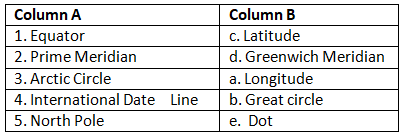Textbook Solutions: Latitudes and Longitudes | Be an Explorer 5: Book Solutions, Notes & Worksheets - Class 5 PDF Download
Quick Zone
Quick Zone
A. Tick (✔) the correct option to complete the sentence.
1. The degree of the Equator is ________.
(a) 0° Latitude
(b) 08 N Latitude
(c) 0° S Latitude
(d) 0° Longitude
Ans: (a)
The Equator is a line of latitude marked as 0° on the globe.
2. The imaginary lines running from east to west around the Earth are called ________.
(a) latitudes
(b) longitudes
(c) Greenwich
(d) poles
Ans: (a)
Latitudes are the horizontal lines that run from east to west on the globe.
3. 180° E and 180° W are one and form the ________.
(a) Equator
(b) Tropic of Cancer
(c) International Date Line
(d) North Pole
Ans: (c)
Both 180° E and 180° W longitudes meet at the International Date Line.
4. 23½° N Latitude is the ________.
(a) Equator
(b) Greenwich
(c) Tropic of Cancer
(d) Tropic of Capricorn
Ans: (c)
It is located at 23½° N latitude.
5. The Royal Observatory at Greenwich is near ________.
(a) London
(b) Paris
(c) Brussels
(d) Oslo
Ans: (a)
The Royal Observatory is located near London.
B. Fill in the blanks.
1. The Earth is ________ in shape.
Ans: The Earth is spherical in shape.
2. The top point of the axis is called ________.
Ans: The top point of the axis is called the North Pole.
3. 0° longitude is called ________.
Ans: 0° longitude is called the Prime Meridian.
4. All ________ are of the same length.
Ans: All longitudes are of the same length.
5. There are total 360 ________ on a globe.
Ans: There are a total of 360 meridians on a globe.
C. Write (T) for true statements and (F) for false statements.
1. The Equator divides the earth into two equal parts. ________
Ans: T
2. The Prime Meridian runs from east to west. ________
Ans: F
3. Poles are near the Equator. ________
Ans: F
4. The Equator and the Greenwich Meridian are the same lines. ________
Ans: F
5. The Northern Hemisphere is greater than the Southern Hemisphere. ________
Ans: F
D. Match the columns A and B.
 Ans:
Ans:
Writing Zone
Answer the following questions.
Q1: Look at the diagrams given. Some numbers have been given on the lines and areas. Name them.
 Ans: 1. South Pole
Ans: 1. South Pole
2. Equator
3. North Hemisphere
4. South Hemisphere
5. Prime meridian
2. What is a grid?
Ans: A grid is a network of lines formed by parallels (latitudes) and meridians (longitudes) on the Earth's surface. It helps in locating a place on a map or a globe by the intersection of latitude and longitude lines.
3. Name the following:
(a) 0° Latitude: ________
(b) 23½° N Latitude: ________
(c) 23½° S Latitude: ________
(d) 66½° N Latitude: ________
(e) 66½° S Latitude: ________
(f) 90° N: ________
(g) 90° S: ________
(h) What is the difference between latitudes and longitudes?
(i) What is the Prime Meridian? Give its other names. Why is it called so?
Ans: (a) 0° Latitude: Equator
(b) 23½° N Latitude: Tropic of Cancer
(c) 23½° S Latitude: Tropic of Capricorn
(d) 66½° N Latitude: Arctic Circle
(e) 66½° S Latitude: Antarctic Circle
(f) 90° N: North Pole
(g) 90° S: South Pole
(h) Latitudes: Horizontal circles, run east-west, 181 in total, measured in degrees north or south of the Equator, distance between them decreases towards the Poles.
Longitudes: Vertical semi-circles, run north-south, 360 in total, measured in degrees east or west of the Prime Meridian, all of the same length.
(i) The Prime Meridian is the 0° longitude line passing through Greenwich (near London). Other names for it include Greenwich Meridian. It is called the Prime Meridian because it serves as the starting point for measuring longitudes and divides the Earth into the Eastern Hemisphere and the Western Hemisphere. The choice of Greenwich was based on an international agreement in 1884.
FAQs on Textbook Solutions: Latitudes and Longitudes - Be an Explorer 5: Book Solutions, Notes & Worksheets - Class 5
| 1. What are latitudes and longitudes? |  |
| 2. How do latitudes and longitudes help in navigation? |  |
| 3. What is the significance of the Equator and the Prime Meridian in latitudes and longitudes? |  |
| 4. How are latitudes and longitudes measured? |  |
| 5. Can latitudes and longitudes be used to determine time zones? |  |
















